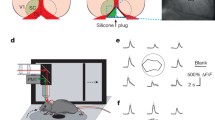Summary
The concept of corresponding retinal points was examined in terms of the binocular receptive fields of neurons in Area 17 of the cerebral cortex of the cat. Only a proportion of the binocular receptive field pairs can be accurately superimposed at the one time in a given plane. The fields which are not corresponding are said to show receptive field disparity. The attempt has been made to establish, on a quantitative basis, the parameters of the receptive field disparities that occur within 5° of the visual axis. A new method was used for defining the zero (vertical) meridian. Very effective paralysis of the extraocular muscles was achieved and the very small residual eye movements that occurred were regularly monitored so that corrections could be applied to the plotted positions of the receptive field pairs. The distribution of the receptive field disparities about the position of maximal correspondence has a range of about ±1.2° (S.D. 0.6°) in both the horizontal and vertical directions for fields in the vicinity of the visual axis. Panum's fusional area may represent the extent to which receptive fields in the one eye, all with the same visual direction, are linked to fellow members of a pair in the other eye over a range of receptive field disparities. A naso-temporal overlap of receptive fields occurs which is probably little if any more than can be accounted for on the basis of the disparity of receptive fields lying along the zero (vertical) meridian. When the extraocular muscles are paralyzed the eyes diverge and the binocular receptive field pairs are separated on the tangent screen. The distribution of the horizontal and vertical separations of the receptive field pairs have been examined.
Similar content being viewed by others
References
Adler, F.H., W.F. Norris and G.E. Schweinitz: Physiology of the eye. 4th edition, pp. 889. St. Louis: C.V. Mosby 1965.
Baldwin, H.A., S. Frenk and J.Y. Lettvin: Glass-coated tungsten microelectrodes. Science 148, 1462–1464 (1965).
Barlow, H.B., C. Blakemore and J.D. Pettigrew: The neural mechanism of binocular depth discrimination. J. Physiol. (Lond.) 193, 327–342 (1967).
Bishop, P.O., W. Kozak, W.R. Levick and G.J. Vakkur: The determination of the projection of the visual field onto the lateral geniculate nucleus in the cat. J. Physiol. (Lond.) 163, 503–539 (1962a).
— and G.J. Vakkur: Some quantitative aspects of the cat's eye: axis and plane of reference, visual field co-ordinates and optics. J. Physiol. (Lond.) 163, 466–502 (1962b).
Boring, E.G.: Sensation and perception in the history of experimental psychology, pp. 644. New York: Appleton-Century 1942.
Brecher, G.A.: Form und Ausdehnung der Panumschen Areale bei forealem Sehen. Pflügers Arch. ges. Physiol. 246, 315–328 (1942).
Chievitz, J.H.: Die Area centralis retinae. Anat. Anz. 4, 77–82 (1889).
Ditchburn, R.W., and B.L. Ginsborg: Involuntary eye movements during fixation. J. Physiol. (Lond.) 119, 1–17 (1953).
—, and R.M. Pritchard: Binocular vision with two stabilized retinal images. Quart. J. exp. Psychol. 12, 26–32 (1960).
Hubel, D.H., and T.N. Wiesel: Receptive fields of single neurones in the cat's striate cortex. J. Physiol. (Lond.) 148, 574–591 (1959).
—: Receptive fields, binocular interaction and functional architecture in the cat's visual cortex. J. Physiol. (Lond.) 160, 106–154 (1962).
—: Shape and arrangement of columns in cat's striate cortex. J. Physiol. (Lond.) 165, 559–568 (1963).
—: Receptive fields and functional architecture in two non-striate visual areas (18 and 19) of the cat. J. Neurophysiol. 28, 229–289 (1965).
—: Cortical and callosal connections concerned with the vertical meridian of visual fields in the cat. J. Neurophysiol. 30, 1561–1573 (1967).
Joshua, D.E., P.O. Bishop and T. Nikara: The precision of the retinal correspondence of binocular receptive fields of single units in the cat striate cortex. Aust. J. exp. Biol. med. Sci. 45, P-48 (1967).
Leicester, J.: The projection of the visual vertical meridian to cerebral cortex of cat and monkey. J. Neurophysiol. 31, 371–382 (1968).
Mitchell, D.E.: Retinal disparity and diplopia. Vision Res. 6, 441–451 (1966).
Ogle, K.N.: Stereopsis and vertical disparity. Arch. Ophthal. 53, 495–504 (1955).
— The optical space sense. In: The eye, Vol. 4, part II, pp. 211–417. Ed. by H. Davson. New York and London: Academic Press 1962.
Otsuka, R., u. R. Hassler: Über Aufbau und Gliederung der corticalen Sehsphäre bei der Katze. Arch. Psychiat. Nervenkr. 203, 212–234 (1962).
Pettigrew, J.D., T. Nikara and P.O. Bishop: Responses to moving slits by single units in cat striate cortex. Exp. Brain Res. 6, 373–390 (1968a).
— Binocular interaction on single units in cat striate cortex: simultaneous stimulation by single moving slit with receptive fields in correspondence. Exp. Brain Res. 6, 391–410 (1968b).
Rodieck, R.W., J.D. Pettigrew, P.O. Bishop and T. Nikara: Residual eye movements in receptive field studies of paralyzed cats. Vision Res. 7, 107–110 (1967).
Stone, J.: A quantitative analysis of the distribution of ganglion cells in the cat's retina. J. comp. Neurol. 124, 337–352 (1965).
— The naso-temporal division of the cat's retina. J. comp. Neurol. 126, 585–600 (1966).
Vakkur, G.J., and P.O. Bishop: The schematic eye in the cat. Vision Res. 3, 357–381 (1963).
— and W. Kozak: Visual optics in the cat, including posterior nodal distance and retinal landmarks. Vision Res. 3, 289–314 (1963).
Author information
Authors and Affiliations
Additional information
Selby Fellow of the Australian Academy of Sciences.
Rights and permissions
About this article
Cite this article
Nikara, T., Bishop, P.O. & Pettigrew, J.D. Analysis of retinal correspondence by studying receptive fields of rinocular single units in cat striate cortex. Exp Brain Res 6, 353–372 (1968). https://doi.org/10.1007/BF00233184
Received:
Issue Date:
DOI: https://doi.org/10.1007/BF00233184



